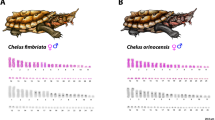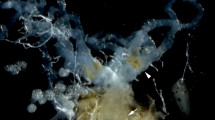Abstract
IT is axiomatic that the chromosome complements of the different individuals comprising a species are identical in number and morphology. The North American ladybird beetle, C. stigma Say (= bivulnerus Muls.), constitutes one of the more striking exceptions in that different males may possess any number of chromosomes from 25 down to 19 (females, 26–20): it is a chromosomally polymorphic species1. The polymorphism here finds its basis in the centric fusion of non-homologous chromosomes, whereby an ‘A’ and a ‘B’ chromosome may be supplanted by an ‘A + B’ fusion chromosome. At meiosis two rod-shaped pairs may thus be replaced by one ring-shaped pair or, in the heterozygote, by a V-shaped configuration of three chromosomes.
This is a preview of subscription content, access via your institution
Access options
Similar content being viewed by others
References
Smith, S. G., Experientia, 12, 52 (1956).
Smith, S. G., Proc. Tenth Intern. Cong. Genet., Montreal, 1, 444 (1959).
Smith, S. G., Ann. Rev. Entomol., 5, 69 (1960).
Author information
Authors and Affiliations
Rights and permissions
About this article
Cite this article
SMITH, S. Tempero-Spatial Sequentiality of Chromosomal Polymorphism in Chilocorus stigma Say (Coleoptera : Coccinellidae). Nature 193, 1210–1211 (1962). https://doi.org/10.1038/1931210a0
Issue Date:
DOI: https://doi.org/10.1038/1931210a0
Comments
By submitting a comment you agree to abide by our Terms and Community Guidelines. If you find something abusive or that does not comply with our terms or guidelines please flag it as inappropriate.



